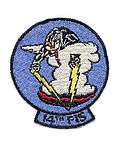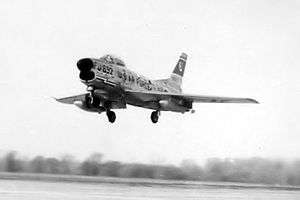14th Fighter-Interceptor Squadron
| 14th Fighter-Interceptor Squadron | |
|---|---|
|
F-86L 53-692 of the 14th Fighter-Interceptor Squadron, about 1958 landing at Sioux City | |
| Active | 1942–1944; 1947-1949; 1953-1960 |
| Country | United States |
| Branch | United States Air Force |
| Type | Fighter-Interceptor |
| Insignia | |
| 14th Fighter-Interceptor Squadron emblem (approved 6 October 1954)[1] |
 |
The 14th Fighter-Interceptor Squadron is an inactive United States Air Force unit. Its last assignment was with the 53d Fighter Group at Sioux City Municipal Airport, Iowa, where it was inactivated on 1 April 1960.
The squadron was first activated in 1941 as the 14th Fighter Squadron. It served in the air defense of the Panama Canal from 1942 until 1943, when it returned to the United States and was a training unit until it was disbanded in a general reorganization of Army Air Forces training units in the spring of 1944. From 1947 through 1949 the 14th served as an Air Reserve unit.
History
World War II
Activated in early 1941 as part of the Southeast Air District, was equipped with a series of pursuit aircraft, stationed at Tallahassee Airport with a mission of air defense of Florida. After the Pearl Harbor Attack, The squadron was one of several hastily deployed to the Panama Canal Zone for the defense of the canal with the United States entry into World War II.
Deployed on 2 January 1942, stationed at Chame Airfield, Panama operating Bell P-39D Airacobras. By 16 February, the Squadron had 12 P-39D's (of which nine were airworthy) and not fewer than 26 pilots, but of these, only four had more than 12 months experience. Following its initial encampment at Chame #1, the Squadron moved to the nearby Chame #2 on 1 April 1942. The unit was redesignated as the 14th Fighter Squadron on 15 May 1942 in keeping with the USAAF scheme at the time.
Following the perceived end of the emergency need for the unit, it returned to the United States in early 1943 where it became a P-47 Thunderbolt, later P-51 Mustang replacement training unit (RTU) for III Fighter Command. Inactivated on 1 May 1944 as part of a reorganization of training units.
Reserve Duty
Reactivated by Continental Air Command (ConAC) in 1947 as a reserve Troop Carrier Squadron at Pittsburgh Airport Pennsylvania. Undetermined if manned or equipped, inactivated due to budget reductions in 1949.
Air Defense Command
Reactivated in 1953 as part of Air Defense Command as an air defense squadron, equipped with F-86D Sabre Interceptors and initially being assigned to Sioux City Municipal Airport, Iowa with a mission for the air defense the Great Plains. In 1957 began re-equipping with the North American F-86L Sabre, an improved version of the F-86D which incorporated the Semi Automatic Ground Environment, or SAGE computer-controlled direction system for intercepts. The service of the F-86L destined to be quite brief, since by the time the last F-86L conversion was delivered, the type was already being phased out in favor of supersonic interceptors.
Inactivated in 1960 as part of the phaseout of the F-86D from active ADC service.
Lineage
- Constituted as the 14th Pursuit Squadron (Interceptor) on 20 November 1940
- Activated on 15 January 1941
- Redesignated 14th Fighter Squadron (Single Engine) on 15 May 1942
- Disbanded on 1 May 1944
- Reconstituted on 3 June 1947
- Activated in the reserve on 13 July 1947
- Inactivated on 27 June 1949
- Redesignated 14th Fighter-Interceptor Squadron on 23 March 1953
- Activated on 18 November 1953
- Discontinued on 1 April 1960[1]
Assignments
- 53d Pursuit Group (later 53d Fighter Group), 15 January 1941 – 1 May 1944
- Eleventh Air Force, 13 July 1947
- 375th Troop Carrier Group, 30 September 1947 – 27 June 1949
- 521st Air Defense Group, 18 November 1953
- 53d Fighter Group, 18 August 1955 – 1 April 1960[1]
Stations
- MacDill Field, Florida, 15 January 1941
- Dale Mabry Field, Florida, 8 May – 18 December 1941
- Chame Airfield, Panama, 2 January-l0 November 1942
- Dale Mabry Field Florida, 26 November 1942
- Drew Field, Florida, 6 January 1943
- Page Field, Florida, 5 February 1943
- Venice Army Air Field, Florida, 10 July 1943 – 1 May 1944
- Greater Pittsburgh Airport, Pennsylvania, 13 July 1947 – 27 June 1949
- Sioux City Municipal Airport, Iowa, 18 November 1953 – 1 April 1960[1]
Aircraft
- Seversky P-35, 1941
- Curtiss P-40 Warhawk, 1941
- Bell P-39 Airacobra, 1941–1943
- North American P-51 Mustang, 1943
- Republic P-47 Thunderbolt, 1943–1944
- North American F-86D Sabre, 1953–1957
- North American F-86L Sabre, 1957-1960[1]
References
Notes
Bibliography
![]() This article incorporates public domain material from the Air Force Historical Research Agency website http://www.afhra.af.mil/.
This article incorporates public domain material from the Air Force Historical Research Agency website http://www.afhra.af.mil/.
- Cornett, Lloyd H; Johnson, Mildred W (1980). A Handbook of Aerospace Defense Organization, 1946 - 1980 (PDF). Peterson AFB, CO: Office of History, Aerospace Defense Center. Retrieved March 23, 2012.
- Hagdedorn, Dan (1995), Alae Supra Canalem: Wings Over the Canal, Turner Publishing, ISBN 1563111535
- Maurer, Maurer, ed. (1983) [1961]. Air Force Combat Units of World War II (PDF) (reprint ed.). Washington, DC: Office of Air Force History. ISBN 0-912799-02-1. LCCN 61060979.
- Maurer, Maurer, ed. (1982) [1969]. Combat Squadrons of the Air Force, World War II (PDF) (reprint ed.). Washington, DC: Office of Air Force History. ISBN 0-405-12194-6. LCCN 70605402. OCLC 72556.
- "ADCOM's Fighter Interceptor Squadrons". The Interceptor. Aerospace Defense Command. 21 (1): 5–11, 26–31, 40–45, 54–59. January 1979.


.jpg)